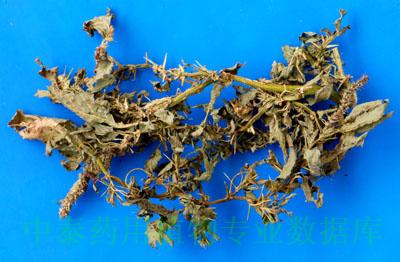| [English Name] | Thorny Amaranth Herb or Root | |
| [Chinese Name] | 刺苋 | |
| [Pinying Name] | Cixian | |
| [Latin Name] | Amaranthis Spinosi Radix seu Herba | |
| [Genera] | Amarantaceae | |
| [Efficacy] | Antipyretic drug | |
| [Pictures] | Plant picture | Drug picture |

|

|
|
| [Alias] | ||
| [Source] | ||
| [Plant morphology] | ||
| [Distribution] | ||
| [Gathering and processing] | ||
| [Characteristics] | ||
| [Ecology] | It grows wildly in wasteland or garden.It resistants to drought and hot,prefers fertilization,has strong vitality,doesn’t resistant to cold and waterlogging.It flowers and sets seed easily in high temperature with short daylight condition. | |
| [Chemical composition] | The whole plant contains n-alkanes(C23-C33), isoalkanes (C29-C33), ester (C18-C32), free alcohols (C20-C26), stigmasterol, β-sitosterol, aliphatic alcohols (C10-C32), stearic acid, cholesterol, free acids (C4-C33), campesterol, oleic acid, linoleicacid, rutin[1]; The stem and leaf contains: hentriacontane, α-spinasterol, lysine, methionine, cystine, tryptophan, alanine, serine, valine, leucine [1]; The roots contains: α-spinasteroloctacosanoate, β-D-glucopyranosyl-(1→4)-β-D-glucopyransyl-(1→4)-β-D-glucuronopyranosyl-(1→3)-oleanolicacid, β-D-glucopyranosyl(1→2)-β-D-glucopyranosyl(1→2)-β-D-glucopyranosyl-(1→3)-α-spinasterol, β-D-glucopyranosyl-(l→4)-β-D-glucopyranosyl-(1→3)-α-spinasterol[1]. |
|
| [Pharmacological activities] | ||
| [Clinical trial] | ||
| [Properties] | Taste: sweet; property: slightly cold; slightly toxic. |
|
| [Medical and other Uses] | Function: dispel heat from blood to stop bleeding, eliminating dampness and heat, removing toxin for eliminating carbuncles Syndromes to be treated: gastrorrhagia, blood in the stool, hemorrhoid blood , cholecystitis, cholelithiasis, diarrhea, vaginal discharge, painful urination, sore throat, eczema, carbuncles, snake bites |
|
| [Dosage] | Oral administration: decoction, dry 9~ Topical application: in right amount, or wash with the decoction, or smashed and smear on the skin. |
|
| [Cautions] | Forbid to be used in the patients with asthenia dysentery for long time and pregnant women. This herb has slightly toxicity, excessive dosage side effects such as dizziness, nausea, vomiting. |
|
| [Traditional usage] | ||
| [Toxicological studies] | ||
| [Pharmaceutical preparations] | ||
| [References] | ||